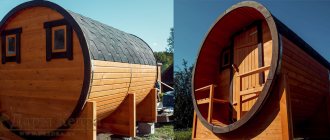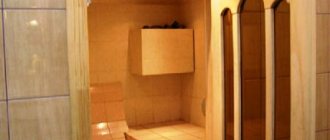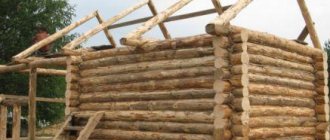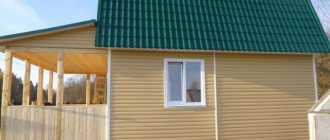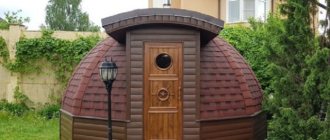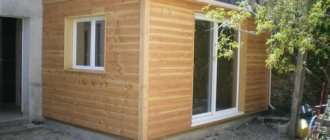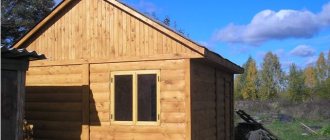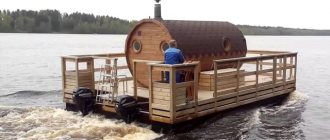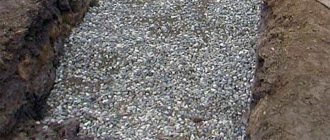A bathhouse in a private area is a functional place for recreational water treatments and family recreation.
An original and fresh solution for a suburban area located near a natural reservoir is a water bath. Modern construction technologies make it possible to quickly and efficiently erect such structures without causing damage to water sources.
Features of an exclusive floating steam room
Few people do not like outdoor recreation. It’s not for nothing that someone said: “The nerves are calmed by a delicious barbecue, fragrant cognac and your favorite little man, and the body is healed by soft steam and herbal decoction!” I would also add that the body is given good health, in addition to steam and decoction, by a biting broom and cold water.
Therefore, I recommend combining business with pleasure in order to please not only the soul, but also the body. For example, visiting a floating steam room is a great idea! Oh, stop. The peasant is for women, and the young lady is for men.
Concept
A floating bathhouse is a mobile structure erected on special prefabricated berths, for the construction of which pontoons are used. They are easy to assemble and disassemble, which allows the steam room to “travel” along the entire river or lake. In addition to the presence of pontoons, a floating steam room is in many ways similar to an “earth” bathhouse.
Components
Several centuries ago, the bathhouse was a tiny room consisting of one room. It would seem, how can one relax comfortably in such a miniature building? As you know, our forefathers did this very well. “Russian fun”, which both heroes and young ladies enjoyed in the bathhouse, are known throughout the world!
For example, after taking a steam bath, women and men ran naked into the street and dived into a snowdrift or an ice hole. Nowadays, of course, this is also practiced, but only in winter, since finding snow in autumn, spring and summer is problematic, and not everyone has the opportunity to build a bathhouse by the river.
Pool? Font? Barrel? Yah. This is completely different. But, as you know, Russian people are cunning. Not so long ago, wonderful structures appeared - floating baths. You can dive into cold water all year round! One room on the raft was not enough, of course. Today, water baths include the following required premises:
- steam room, which has a comfortable shelf;
- a terrace with a canopy, on which there is a table, chairs, and a barbecue;
- a bathroom with a shower stall, sink, and toilet;
- dressing room, which contains a bench, a wardrobe, a shoe stand and hooks for clothes, bags, etc.
Floating bathhouse on barrels
In addition, the owners of bathhouses on the water equip their “treasure”, which, to be honest, brings considerable income, with other premises:
- a comfortable and presentable relaxation room with a jacuzzi;
- ergonomic and aesthetic diving tower;
- luxurious kitchen and fashionable bar;
- landscaped sunbathing area.
Of course, if you wish, you can create something exclusive. The main thing is imagination! Don't be lazy. Believe me, you will not regret it, because as a business, a floating sauna is incredibly profitable. After all, the Russian people are greedy for fun.
What else? Safety. It’s difficult to call an “earth” bathhouse safe, and even more so a steam room on water. Therefore, “on board” you need:
- durable guardrails designed to prevent accidental falls;
- high-quality and charged fire extinguishers;
- life jackets and rings;
- qualified sober rescuers;
- first aid kit.
Before you start manufacturing a particular structure for a bathhouse, you need to consult with highly qualified specialists in order to avoid unpleasant situations.
Advantages and disadvantages of a floating sauna
Like any other design, a water bath has a lot of advantages! What is good about a floating steam room? Well, if you believe the reviews, the design:
- durable;
- wear-resistant;
- mobile;
- aesthetic;
- exotic;
- comfortable;
- multifunctional;
- economical (in terms of space);
- relatively inexpensive - from 30,000 rubles per m2.
In addition, procedures in such an extravagant steam room are incredibly beneficial for both body and soul.
The design has no drawbacks as such, except that you can’t swim in winter...
In general, dear extreme lovers, a bathhouse on the water is a structure that gives not only colorful emotions, but also a decent income to its owner!
Horror stories for a water bath
Among the most significant disadvantages of a floating steam room, we can only mention high humidity and direct contact with water, due to which metal parts rust, wood rots, and the insulation and firewood supply get wet.
The second most important drawback can be considered the isolation of the bathhouse from the outside world. On the one hand, this only increases the level of comfort, but on the other hand, any injury or unusual emergency situation will remain without the help of a doctor or any other specialist.
Security questions
The greatest danger to a floating sauna is not even fire, as many amateurs claim, but water. According to statistics from floating baths:
- 85% work safely and serve water recreation enthusiasts;
- 0.5% burned due to fire safety violations;
- 14% drowned, were intentionally flooded, or caused a water accident.
For your information! Preventing possible fire problems will not be difficult if you use special safe gas-heated stoves and stock up on fire extinguishing agents.
Problems with the destruction of the structure of a floating bathhouse are much more serious. Usually it is due to lack of experience in building a steam room on pontoons or, as is more often the case, attempts to use a sauna platform, self-propelled or not, in conditions that were not intended for it.
Bathhouse on the water: projects
All existing schemes for constructing a floating steam room can be divided into three categories:
- House on a raft;
- Towed floating baths;
- Conversion of a small vessel, boat, catamaran or assembly of several boats into a bathhouse.
In the latter case, the bathhouse takes on its own course. Thanks to a small outboard motor, the floating bath complex can be driven 100-200 m from the shore and returned to the pier in the evening or in case of emergency.
House on the water project
There are more than enough options for constructing a bathhouse building on a floating platform. Structurally, the bath complex is built from two large modules:
- Bathhouse box with heating equipment, insulation and rest area;
- Floating platform with pontoons.
As a rule, there are no problems with building a bathhouse. Usually they use a standard timber frame house or a frame house, reinforced at the base with additional stiffeners, photo.
To equip a floating platform, you can make it from logs or use ready-made modules. A sauna on a raft looks quite confident, but only if the dimensions of the room do not exceed 3x4 m.
The main difficulty in building floating steam rooms is the correct alignment of the room relative to the raft or platform. The load capacity of the base is usually calculated based on the weight of the structure plus 600 kg for firewood and passengers.
If an error is made in the calculations of a floating bath, it can be corrected by installing tied polyethylene barrels. By collecting a certain amount of water into containers placed around the perimeter of the raft, it is possible to balance and raise the floating platform above the water surface of the reservoir.
Pontoon construction
Floating baths on a platform made of pontoons are considered the safest and most reliable in operation. Traditionally, the frame for the base is made from oak or hardwood timber or, more recently, from an aluminum profile.
Plastic or steel 100-liter barrels are attached to the bottom of the floating bathhouse in three lines, according to a catamaran pattern. As a rule, the buoyancy reserve of a bathhouse on a pontoon allows you to remain on the surface of the water even in a situation where half of the tanks are flooded.
A steam room box on pontoons can be placed almost anywhere on the site, thanks to this you can create a bathhouse with access to the water; a folding staircase allows you to go down into a river or lake without leaving the room.
Advice! If the floating bath complex is planned to be used for a long journey on water, then in this case the supporting frame and platform must be mounted on industrially manufactured pontoons.
For example, the well-streamlined Tristan-3M allows you to tow a floating bathhouse with a motor boat, while the strength, quality and durability of the pontoon block are many times greater than homemade foam and barrel structures. Thanks to the fiberglass walls and the special shape of the body, bathhouses on a pontoon can be left for the winter on the coastal line of a reservoir.
Floating sauna based on a boat
The most reliable way to ensure safe relaxation and visiting a steam room on the water involves using the hull of a boat or river pleasure boat as the basis.
One of the options for a comfortable floating bath is shown in the figure below. In fact, this is not even a steam room, but a full-fledged residential building on the water:
- The dimensions of the room are 5x3 m, of which 2x3 m is allocated for a relaxation room, 1.2x1.5 for a shower, the rest for a steam room and a kitchen. Ceiling height 180 cm;
- The floating sauna is provided with electricity, hot and warm water by a 30 kW propulsion motor;
- The body of the bathhouse is made of waterproof plywood, insulated with foam plastic and fiber mats, and lined with cedar lining inside.
For your information!
The floating house-sauna of this project allows you to travel a distance of up to 200 km and easily control the waves on large reservoirs and rivers. If necessary, the floating version of the yacht-sauna can be easily transported on a trailer to any suitable body of water.
We build the frame
So, if the stove-heater is located inside the steam room, then the frame is installed around it. Then the four corner posts are driven into the soil and connected at the top along the perimeter with poles. In this way you can make a bathhouse in the shape of a cube or parallelepiped. The choice should be based on the number of people who want to be in the steam room at the same time.
Fasten all the poles together with wire, rope or tape. The latter is useful for wrapping sharp corners of the frame, which can damage the film if you use it as a covering material.
Photo from the site pp.vk.me
When you have installed the frame and flooded the sauna, take care of the floor of the steam room. To avoid sitting on the cold ground, lay down travel rugs or place folding chairs. If the size of the bathhouse does not allow it or such props are not available, cover the ground with spruce branches and sprinkle leaves on top.
Next, cover the frame with thermal insulation material.
Design
The construction of a floating sauna is slightly different from the construction of a steam room on land. For example, “earth” structures are built on a pile, strip, columnar and monolithic foundation (depending on the soil) from a variety of materials. And floating health resorts are built mainly using frame technology, since they must be lightweight, otherwise they will have to build a pontoon the size of an aircraft carrier. Although, there are always exceptions...
It, that is, the pontoon is made of plastic, metal or wood. Plastic construction is used most often because it has a long service life. But if the climate is seriously harsh, you will have to take out the steam room, since wintering in the ice will not lead to anything good. A pontoon requires an anchor, so you can “park” almost anywhere.
By the way, in order to circumvent the conditions for placing a bathhouse in a water protection zone, many owners of steam rooms install non-self-propelled barges under the structure, which are considered a floating device.
Regarding the body, it can be identical to an ordinary “earthly” steam room. Oh, by the way, today the barrel sauna proudly flaunts in the dazzling rays of glory. It is compact, attractive, comfortable and known for its reasonable price.
Where does the water drain from the sink? In special containers located under the bottom. After which it is poured into the sewerage system or into settling tanks on the shore. Many bathhouses, whose owners did not skimp on the arrangement, are equipped with filtration systems. What does it mean? The water is immediately discharged into the reservoir after purification, which is very convenient and practical.
As you can see, there is nothing supernatural about floating steam rooms, but, nevertheless, they give a fabulous experience! I can personally confirm this: about 5 years ago I was in Novosibirsk at the Ob Reservoir. There are no limits to emotions...
Design nuances
All columnar foundations can be divided into two types:
- Recessed. The bottom of such foundations should be 0.5-1 m below the freezing point of the ground in the region. This option is suitable for clay soils and can also be used in conditions of high groundwater levels.
- Shallow foundations sink 0.4-0.7 m into the ground. They are suitable for soils with high bearing capacity.
Despite the fact that a wooden bathhouse is a lightweight structure, on heaving soils it is better to use a buried columnar foundation. The thing is that in the case of using a shallow foundation with a small weight of the entire structure, heaving forces will affect the foundation more strongly than the weight of the building. This can lead to deformation of the structure and the formation of cracks.
Depending on the material used, the optimal cross-section values for the columns are as follows:
- stone pillars can be made with a cross section of at least 50-60 cm;
- brick columns are laid out with a section of 380x380 mm;
- monolithic structures are poured with dimensions of 400x400 mm;
- wooden poles are usually made from logs with a diameter of at least 0.2 m.
To correctly determine the dimensions of the pillars, it is necessary to perform an engineering calculation, which takes into account the following indicators:
- the weight of the entire structure;
- geological conditions and soil composition;
- soil freezing depth (the bottom of the pillars should be below this mark);
- height of groundwater and seasonal changes in this level. It is best that the pillars do not reach the groundwater level.
Bathhouse afloat: construction features
Building a full-fledged floating steam room will not be difficult even for novice lovers of water recreation. First of all, you will need to correctly plan the dimensions of the future platform, calculate the total weight of the structure, taking into account the payload in the form of drinking water, firewood and passengers.
Next, the volume of future pontoons is determined; to calculate buoyancy provision, half the total displacement of buoyancy modules or barrels is taken.
Materials
The supporting platform of a floating bath is made of a square pipe, a steel angle or a metal profile.
Waterproof bakelite plywood is used for the deck; sanded oak boards are often laid in the washing area and rest areas.
Pontoons or barrels are made of fiberglass, cold covered with fiberglass cloth on epoxy resin. For full-size floating baths, ready-made buoyancy modules made of rotationally pressed polyethylene are used.
Pontoon installation
Polyethylene buoyancy modules are manufactured in a standard shape with mounting grooves.
The blocks are connected with locks with little effort into single pontoons. The buoyancy element is attached to the metal frame of the floating bathhouse using pins and embedded elements.
If the floating platform is assembled on fuel barrels, then each container is fixed to a steel frame with strap clamps with adjustable tightening force.
This version of the platform for a water bath is cheaper, can withstand more weight, but requires periodic anti-corrosion treatment of the barrels and frame.
Construction of a bathhouse
The design of the water steam room differs from the stationary model only in the method of waterproofing and the room ventilation system. Unlike land baths, a floating steam room is subjected to mastic treatment of the external surfaces of the walls, vestibule, and base of the bottom of the building.
Usually the room is made using a frame method from a galvanized metal profile. A foiled mineral board is used as insulation for the steam room, and the outer layers are laid out with foam plastic boards.
All wooden parts of the structure are coated with epoxy varnish, used in the construction of yachts and boats. Any oil, pentaphthalic, alkyd, acrylic impregnations are not used.
How to build a water bath and what needs to be provided
Sometimes you can come across the most original human solutions, among which, for example, you can highlight a floating bathhouse. For a long time, after bathing procedures, people try to either douse themselves with cold water or jump into a snowdrift. And it is not surprising that a water bath was invented. Actually, how to build a floating bathhouse will be discussed in this article.
General concepts regarding the construction and maintenance of a bathhouse
If you decide to build a water bath, then before you begin work, you need to familiarize yourself with the list of important points:
- Reservoirs, as a rule, are federal property, that is, they are subject to environmental legislation. This means that construction must be confirmed by regulatory documents. Especially when it comes to the desire to build a bathhouse on a pontoon in areas of nature reserves and seasonal fish spawning. As practice shows, privately obtaining permission to build and further use a water bath will require large financial investments, so most often only companies associated with leisure activities can do this.
- It is also worth considering the fact that after the construction of a bathhouse, the issue of liability for subsequent operation is not closed. It will be necessary to pay constant attention to the construction, control the node connections and the floating capabilities of the bathhouse. All these nuances indicate the peculiarity of the problems, which requires the owners of such a building to exercise double control so that the soaring process does not turn into an event to rescue people from a sinking vessel.
- In addition, keep in mind that due to the high danger of the structure itself, the entire list of work must be carried out either by professionals or without their help, but subject to one hundred percent compliance with all rules and safety precautions.
Preparation and design stage
If you have definitely decided that you will build a bathhouse on the water, then you should study the entire construction sequence, strictly adhere to it in the future and carry out the work with maximum efficiency.
First comes the preparatory stage. It determines the type of pontoon, and also makes a drawing of the future structure. It is worth noting that, in fact, the design of a water bath is practically no different from the usual bathhouse. The main thing is to solve the problem of how it will stay afloat.
Often, to solve this problem, they install a pontoon, which comes in three types:
- Metal pontoon. It can be manufactured either at any factory or made to special order. This version of the pontoon is considered expensive, and it also requires constant maintenance (cleaning and painting).
- Plastic pontoon. This variety has significantly less weight and is also designed for higher loads. In addition, it is worth keeping in mind that such pontoons are manufactured only in factories, so there is no doubt about their quality.
- A type of pontoon made of wood. Installed more often than plastic. This is partly due to the fact that in areas with a temperate continental climate, with harsh winters, reservoirs can freeze, which is why the plastic option simply disappears.
Pontoon installation
Once you have decided on the type of pontoon, you can proceed directly to its installation.
The plastic pontoon version just needs to be assembled according to the instructions. Regarding the wooden pontoon, in this case you will need to do a little more work. The main thing in this case is to decide on the material for the manufacture of floating elements. As an option, you can use floating steel barrels.
Pipes with thin walls but large diameter are also suitable. They will need to be welded on both sides. Many of these elements are fastened together to form a raft. It differs from the usual one in that it will have to hold much larger loads. Such a raft must be secured to the shore by the base with steel chains.
Construction of a bathhouse
After manufacturing and installing the pontoon, you can begin to build the bathhouse itself. In this case, the list of works will be the same as in the ground version, but it is better to pay attention to materials that have as little mass as possible.
For example, the frame of a bathhouse can be made not of oak, but of metal profile pipes. They can later be sheathed with clapboard. Although, you don’t have to create problems for yourself, but install a ready-made type of bathhouse that can be assembled locally, already on a pontoon. This will significantly reduce time and effort, and the bathhouse will look more practical.
This was the last stage in the construction of a bathhouse on the water, that is, the issue can be considered resolved. Naturally, the description presented above is generalized, not entirely detailed, but it is quite possible to put together an overall picture of the basics and main principles of the work.
Styling is a treasure trove of ideas
As you know, people love with their eyes. Therefore, the objects that are part of the bath and health complex must proudly demonstrate a single style. In addition, we should not forget about the territory on which such a structure sits. So, what's in fashion now? Today the following are in demand:
- colorful Russian style;
- picturesque Moorish destination;
- eloquent Provence.
We will now get acquainted with the features of construction in one direction or another, but briefly. And you can study detailed information by watching master classes by famous specialists in the art of construction.
Provence: a place where harmony reigns
A bath option in a lovely Provence style is:
- old-world charm;
- light color palette;
- wooden interior items with forged elements (artificially aged) without sophistication;
- homespun wool carpets;
- linen towels and tablecloths;
- faded curtains;
- thick-walled ceramic dishes;
- rough plaster with exposed stonework;
- forged chandeliers;
- fireplace with wooden or stone facade;
- flowerpots with cypress trees;
- walls covered with ivy or wild grapes;
- pots of heather and lavender;
- spicy aromas.
Provence is a rural idyll and a welcome spirit of the old but good times!
Moorish style: a place where peace reigns
The bath complex in the mysterious Moorish style is:
- colorfulness and sophistication;
- floral patterns with elements of Arabic script;
- spicy plants;
- many benches and sunbeds;
- grass instead of paths;
- miniature fountains here and there;
- bright mosaics;
- luxurious stained glass windows;
- wonderful arched vaults;
- forged copper lamps;
- amazing hookahs;
- large vases;
- tablecloths, curtains, rugs, bedspreads with embroidered gilded ornaments;
- wood trim;
- figured carving;
- jingling decorations on the walls and ceiling;
- a huge number of pillows scattered everywhere;
- antique tea sets;
- clay bowls.
Moorish style is a marvel, conducive to mental balance!
Russian style: a place where fairy tales rule
An option in a colorful Russian style is:
- decorative mill in a pond;
- wooden sculptures in the form of fairy-tale characters;
- paths made of stumps or bark;
- cherries, plums, apples, pears;
- viburnum, raspberries, strawberries;
- mint, lemon balm, poppies, periwinkle, lupine, tobacco, sweet pea;
- sunflowers, chamomile, peonies;
- a huge stump in the form of a table;
- small stumps that act as chairs;
- benches made of wood;
- wood finishing material;
- linen towels;
- cotton tablecloths;
- chintz curtains;
- striped wool runners;
- a stove decorated with tiles;
- artificially aged surfaces;
- Palekh boxes;
- Gzhel porcelain;
- Khokhloma dishes.
Russian style is an atmosphere that pampers you with magic!
In addition to these styles, the following areas are in demand:
- colorful country;
- laconic minimalism;
- daring loft;
- functional high-tech;
- elegant classicism;
- noble baroque.
There is plenty to choose from! There would be a desire and financial capabilities. And there it’s already a matter of small things... Moreover, you can order a design of a bath complex according to your desires and needs from us.
So, making your dreams come true is an incredibly interesting process that gives amazing results! If you get a little carried away, you can create a real masterpiece to the envy of your friends and to the delight of your household.
Wild imagination to you, dear readers! And, of course, health!
Wisdom Quote: The fewer faults we have, the more tolerant we are of the faults of others (Samuel Johnson).
Installation of a pontoon for a bath
Most often, a floating bathhouse is installed on a pontoon or screw piles made of metal. The pontoon foundation is designed for artificial and natural reservoirs of varying depths. Metal piles are suitable for artificial reservoirs with a dense bottom and calm water surface.
To fix the pontoon, fastening anchors are used, and the fixation process itself is performed:
- briquettes and pipes;
- chains and weights;
- shore clamps.
Fixation with briquettes and pipes
This method of fastening involves the use of metal pipes driven 100 cm into the bottom. Installation of pipes requires the use of specialized equipment. The diameter of the supports is selected taking into account the dimensions and weight of the bath. Briquettes are attached to the installed supports, on which the pontoon is fixed.
A finished bathhouse on this basis can be used at any time of the year without the need for dismantling.
Fixation with chains and weights
The most affordable option for installing a pontoon. In this case, the sinkers are reinforced concrete piles and slabs to which chains are attached, after which they are immersed in the water near the shoreline. The pontoon base is fixed to the chains. The chains must have an appropriate length that will allow the finished structure to be freely kept afloat.
This method of fixing the pontoon involves dismantling it in winter and moving the bathhouse to a flat base.
Shore clamps
Installation of the finished structure on the shore using reinforced concrete piles, to which the pontoon is attached to metal cables or chains.
How to assemble
The next stage in the construction of a bathhouse is the assembly of wall structures. As a rule, a bathhouse on pontoons is built from wood, which is lightweight and has good performance characteristics.
The assembly is carried out on a rigid base, which is fixed to the pontoons with dowels. In the lower part, the structure is treated with clay mortar, which will provide additional protection for the wood from increased moisture.
It is recommended to assemble the frame on the shore, then move it and fix it on the base. Insulation and decorative finishing work is carried out on an installed pontoon.
In order for the finished sauna on a raft to be used correctly, at the stage of assembling the structure it is necessary to perform a high-quality installation of the drainage system. Wastewater must accumulate in a special tank under the bathhouse and then be discharged ashore.
Additionally, you can install a filter for multi-stage wastewater treatment. An expensive system that will preserve the environmental friendliness of the water source throughout the entire life of the bathhouse.
Durable, safe and lightweight materials are used for the roofing structure.
A floating sauna is a reliable and practical structure, which in its performance characteristics is not inferior to a traditional building.
Arrangement of the stove-stove
Stove for a camp sauna.
To construct it, you need flat, small stones, the size of your palm. This form of cobblestones heats up quickly and retains heat for a long time. The design of the heater is multi-layered. First, a small pile of firewood is piled up, then stones are placed one on top of it, then another layer of firewood. Such a pyramid ends with a hill of stones. The dimensions of the structure will be approximately 70 cm in height and the same in length and width. As a result, this design has a niche in which a fire is lit. The stone structure retains high temperature; a stone slab or a metal grate taken with you must be placed on top of it. Pots with water are placed on them to heat it.
The design described above is used for black baths. It provides good heat. There are two types of stone laying:
- A large boulder is placed in the center of the proposed stove, and then smaller stones are placed around it. Inside the pyramid, firewood is placed between the central stone and the surrounding stones. They are set on fire at the same time.
- A U-shaped structure is laid out of stones, in the center of which a hole is created. A fire is created in it; when it is lit, all the stones are heated and the entire created structure is evenly heated.
It is necessary to maintain a fire in any stove for three hours. While the heater is heating up, you can begin to build a base for the tent, and also put water on the fire to heat it up so that it has time to heat up before the procedure begins.
Projects
A lot depends on the type of project chosen during construction and use. There are several main options for floating baths:
- houses placed on a raft;
- towed buildings;
- converted boats and catamarans, other types of small vessels;
- boat assemblies.
When a floating sauna is made on the basis of floating devices, it will have an autonomous movement. The easiest way to provide it is with a mounted outboard motor. With the help of such an engine, the building is moved from the shore 100-200 m, and then, if necessary, returned to the pier. In any case, the water bath is divided into two main components: the building box with all the necessary “stuffing” and infrastructure and the supporting platform. The building itself is created without any problems; most often they build a log house or form a frame house with a reinforced base.
Floating platforms can be made from logs or based on ready-made modules. Experts note that even on a special pontoon - and even more so on a raft made by yourself - you should not build a structure larger than 3x4 m. Otherwise, the load will be excessively large.
Particular attention should be paid to correctly determining the center of gravity of the building. To simplify the calculation of the load, they focus on the total mass of the structure with an addition of 600-800 kg (visitors, necessary things).
Mistakes made are corrected by installing polyethylene barrels. By filling them with water or pouring it out as needed, you can ensure the perfect balance. Professionals note that the use of pontoons is safer than traditional support on a simple raft. Most often, frames are made on the basis of larch or oak timber. In recent years, pontoons made of aluminum profiles have been gaining popularity.
The balancing barrels are fastened in three lines, according to the so-called catamaran scheme. Usually, when calculating a project, they strive to ensure that the bath remains on the surface even when half of the tanks are filled. The steam room box is placed in a randomly selected place on the platform. Some people prefer direct access to the water via a folding ladder without leaving the room.
When they plan to travel on water for a long time in a bathhouse complex, both the supporting frame and the upper platform are placed on industrial-style pontoons.
Conclusion
How to make a camp sauna and what to use for it depends on your desires and capabilities. Naturally, if you travel on foot, carrying a ready-made stove and a tent with a frame is quite expensive. In this case, the easiest way is to carry only a ready-made awning, and build the frame and stove on site (see also the article “Do-it-yourself camping sauna - in nature with comfort”).
If you are a fan of car travel, then you can carry a complete set and build a mobile steam room in a matter of minutes
Moreover, its size can be very impressive, which is important when vacationing with a large group
Construction technology
A floating steam room differs from one installed on the shore only in increased requirements for waterproofing and specific ventilation. You will definitely need to treat all external surfaces with mastic - and especially the base of the building. The use of frame floating baths based on galvanized profiles is widespread. For insulation, a mineral wool slab with a foil layer is often used. The outer layers are formed on the basis of foam boards.
Any wooden parts must be coated with a layer of epoxy yacht varnish. Other impregnations will have to be abandoned.
It is necessary to fix the pontoon using briquettes and pipes if they can be deepened into the bottom by 1 m, but it is easier to use cables or chains. The work will require the use of special machines; the supports must correspond to the size and weight of the bathhouse.
Adviсe:
- coat the bottom with clay;
- assemble the frame on the shore, then move it to the desired location;
- provide multi-stage filtration of wastewater;
- cover the roof with metal tiles.
External awning arrangement
You must take the material to cover the frame with you. It's unlikely to be found locally. To ensure the tightness of the steam room space, it is necessary to use materials with weak vapor permeability. It can be polyethylene, tarpaulin or any other dense material that is used to cover a rigid frame.
As a last resort, you can use the outer awning of modern tents, but this is not a very good option, since this material is not designed for high temperatures. After tensioning, the awning should be pressed along the perimeter of the junction with the ground with stones or other available material. If the awning consists of several parts, it must be taped at the joints.
Features of the structure
Are you interested in a floating sauna? In this case, make a reservation. Ah-ah-ah! Do you want to have your own “treasure” on the water? I understand. Then start developing the project and do not forget to take into account the features of its construction. What are the features?
- Secured territory. It is prohibited to build and operate a bathhouse in a water protection zone. The environment strictly monitors this.
- It is allowed to build a steam room on a raft if the dirty water is discharged outside the water protection area or is purified through a multi-stage system.
- In addition, if you are planning to lower the bathhouse onto the river, you need to coordinate this with the relevant authorities.
- If you plan to place a steam room on your own pond, approval is not required. But you need to think about the type of treatment system, since a picturesque pond will turn into an obscene swamp in the shortest possible time.
Arrangement of the canopy
While firing a makeshift stove, you can start constructing a frame for the canopy, which is assembled from six strong pieces (stakes) cut from tree trunks. We sharpen four such blanks at one end and drive them into the ground at the corners of the area marked around the heater at a distance of about 2 meters from one another. We fasten the remaining two stakes crosswise on top of them, securing them with insulating tape, both at the crossing point and at the points of connection with the stakes driven into the ground.
The material for making the canopy in our case is thick polyethylene, which must be stored in advance and measured based on the size of the camp bathhouse. If the size of the proposed site for the bathhouse is 2x2 meters, then to arrange the canopy you will need a piece of polyethylene measuring approximately 4x9 meters. After the stones are thoroughly heated, the fire must be extinguished and all ash formed as a result of combustion must be removed from the heater.
Immediately after this, you can begin assembling the canopy from a previously prepared piece of polyethylene. Operations for assembling the “roof and walls” of a camp bathhouse are carried out, as a rule, in the following sequence:
- We check the strength and reliability of the assembled canopy. (In passing, we note that in order to strengthen the joints of the stakes with the crossbars, as well as the crossbars between each other, in no case should you use wire, since the heat heats it up and melts the polyethylene).
- It is first recommended to throw a cloth made of any dense material over the resulting frame, which will protect the polyethylene from excessive heat and accidental damage.
- And only after this can polyethylene be stretched onto the frame, cut in the form of two awnings, each of which is fixed to the ground with the help of stones. The entrance to the bathhouse is formed at the junction of the two halves of the canopy, and one of the awnings must have a certain supply of film to form an “overlapping” joint.
To increase the tightness of the structure, the lower edges of the improvised walls of a camp bath can be covered with stones in some places.
General aspects of building and maintaining a bathhouse
If you decide to build such a room, you should know that before starting work you need to be clearly aware of a number of things:
- Reservoirs are most often federal property and are subject to environmental legislation. In accordance with these regulatory documents, construction should be carried out, if it takes place at all. This is especially true when it comes to the construction and use of such structures in nature reserves or seasonal fish spawning areas. It is worth noting that in private, obtaining a construction permit and the subsequent use of a floating bathhouse can cost quite a decent amount, so in most cases only organizations involved in leisure activities dare to take such a step.
- In addition, it is worth thinking about the fact that building a bathhouse on the water will not close the issue. The bottom line is that the operation of such a building requires constant attention. It is necessary to tirelessly monitor the serviceability of all node connections and, in general, the overall buoyancy of the bathhouse. The very combination of these words hints at the unusual nature of the problem, and therefore double caution must be taken so that bath procedures do not turn into an operation to rescue people from a sinking ship.
- You should also pay attention to the fact that due to the potential danger of the structure, all work must be carried out either by specialists or independently, but with strict adherence to all rules and, mainly, safety precautions.
Benefit
Costs must be calculated in strict accordance with the region and the scale of the establishment. This is the only way to determine the starting capital and figure out future profits.
Initial costs include the following:
| Expenses | Sum | |
| 1. | Land plot, construction of a bathhouse or purchase of a finished building, installation and installation of equipment | From 2 million rubles |
| 2. | Current expenses | From 150 thousand rubles |
| 3. | Purchasing additional materials for the bath | From 100 thousand rubles |
| Total: | From 2250 thousand rubles |
At the same time, it is worth paying attention to the purchase of all accessories for visitors, which will include brooms, bathrobes, towels and other services. If prices are set correctly for the provision of all services, including rental of halls, barbecues and other facilities, with an average workload you will receive about 220 thousand rubles monthly, of which 70 thousand is net profit
In about two and a half years, all investments will fully pay for themselves. At the same time, you should not save on advertising, since this is what will provide you with regular customers and profit.
A bathhouse is not only a pleasure that hundreds of people have been striving for for many years, but also an opportunity to earn good money, while at the same time getting the opportunity to carry out wellness procedures on their own.
Security questions
The greatest danger to a floating sauna is not even fire, as many amateurs claim, but water. According to statistics from floating baths:
- 85% work safely and serve water recreation enthusiasts;
- 0.5% burned due to fire safety violations;
- 14% drowned, were intentionally flooded, or caused a water accident.
For your information! Preventing possible fire problems will not be difficult if you use special safe gas-heated stoves and stock up on fire extinguishing agents.
Problems with the destruction of the structure of a floating bathhouse are much more serious. Usually it is due to lack of experience in building a steam room on pontoons or, as is more often the case, attempts to use a sauna platform, self-propelled or not, in conditions that were not intended for it.
Requirements
Arranging a bathhouse afloat has serious advantages. You will be able to swim directly after the bath procedures. Problems with water supply and sewerage are automatically resolved. However, you will have to take into account constantly high humidity and contact with water, isolation from the outside world.
Important: according to statistics, fires threaten floating bathhouses 28 times less than flooding or other water-related accidents.
You will definitely have to use stoves of a special design - only with gas heating and increased security. It is required to have a supply of fire extinguishers and other means to suppress fire in the floating bathhouse. Only those who understand the use of pontoons should build such a structure. The essential components of a floating sauna are:
- fences (to prevent accidental falls into the water);
- special floor coverings (that do not slip and do not support combustion);
- equipping with life jackets (at least 1 per user);
- availability of life preservers.
An exact list of requirements can always be obtained from small boat inspectors.
You cannot build a bathhouse in a conservation area, nature reserve or national park. It is worth considering that all waste water must be disposed of outside protected areas. An alternative solution is the use of high-capacity septic tanks. Otherwise, there are almost no special requirements, and you can be guided by your preferences.
Bath day with hay.
In terms of volume, we will need a well-filled bag of hay. Before visiting the bathhouse, put the hay on the shelves. To avoid fire, moisten it with water, and during your visit, pour boiling water over the hay. The aroma of steam at this moment is difficult to describe!
Upon completion, we take the hay out onto the deck to dry so that it does not rot on the shelves, or throw it away.
After every visit to the bathhouse, you want to dive into the clean Don.
The rules are as follows:
- If the raft is located near the shore, for safety, hang a lifebuoy on a rope at the stern.
- Jump into the water only feet first, carefully, without aggression, or go down the ladder.
- It is prohibited to jump into the water with your head. Shallows and sloughs in the water are unpredictable.
- You can also rinse off with a bucket right on the deck.
Pontoon installation
If the issue with the type of pontoon used is resolved, then you can proceed to its installation.
The plastic version is simply assembled according to the instructions. If we are talking about a wooden pontoon, then there is a little more work to be done. The main question is what to use as floating elements. An example is metal barrels. You can also use thin-walled large-diameter pipes that are welded at both ends. These “floats” must be connected together in such a way as to form a kind of raft, with the difference that it can withstand impressive loads. The base is attached to the shore or pier with metal chains.
Preparation and design
If the decision to build a floating bathhouse is finally made, then it is necessary to carefully study all stages of construction and subsequently carry them out as carefully as possible.
Water bath project
First of all, there is a preparation stage. It is necessary to decide on which pontoon the bathhouse will be built, and also to draw up a detailed drawing of the future building. The bottom line is that, by and large, the construction of a floating bathhouse is not much different from the construction of a regular one. The main problem is to make the bathhouse stay afloat. This is usually achieved by installing it on a floating pontoon, which can be of three types:
- Metal pontoon. This may be a factory-made or custom-made design. This option cannot be called cheap; in addition, constant maintenance will be required - cleaning and painting the body.
- Plastic pontoon. This option is lighter in weight, which means it can withstand greater loads. It is also worth considering that in this case we are talking about a factory-made version, so you can predict the final result with some accuracy.
- Wooden pontoon. This option can be found more often than the previous one. The fact is that in areas with a temperate continental climate there are distinct seasons, and water bodies most often freeze in winter, which makes the use of plastic pontoons impossible.
Wakeboarding
This is an extreme sport that looks extremely chic when performed by professionals. These include acrobatic stunts, insane speed, and the beauty of movement.
If you are a beginner, then even just riding a wake will inject a fair amount of adrenaline into your blood - we know, because we once rode with the entire editorial team (the developer fell the most, but this happens in his life too, so it doesn’t matter)
The whole point of wakeboarding is that you hold on to a halyard that pulls you along the surface of the water. The cable can be connected to an electric motor (cable wakeboarding), or it can be attached to a boat (boat wakeboarding). Your task is to maintain balance and move along an already given route. If you can perform a trick using a running wave or a springboard, then well done, but if you fall, then it’s okay. The boots are rigidly fixed to the board.
Bathhouse on the water: photo
The design and decoration of the floating bath complex is selected in accordance with one’s own preferences. This could be a barrel sauna mounted on a wooden raft.
Full-size floating complexes are built in the form of log houses or wooden houses on a pontoon platform.
In the case of using steel buoyancy blocks, it becomes possible to arrange a recreation area on the roof of the building.
Small floating baths made from sleepers look original.
There are even camping options for floating bathhouses for traveling on water.
What kind of baths are built on water?
Building a bathhouse on the water is not as simple as it seems at first glance. The foundation of the bathhouse is based on either metal pillars or floating pontoons made of plastic. The structure itself is assembled from timber or logs. Since you should not choose a heavy box. The best option is frame construction.
The design of a water bath should be as simple as possible
The load must be calculated down to the smallest detail, so that if steamers are grouped in one part of the bathhouse, the structure does not turn over or become warped. The number of people simultaneously visiting a water bath must be strictly regulated. It also takes into account whether the water in your region freezes or not. In winter, a bathhouse on pontoons will have to be moved to the shore, since the floating structure can simply be crushed by ice. You can use a non-self-propelled barge as a base for a bathhouse. Of course, the price for such a project is high, but for a commercial bath it is quite worth it. So, large floating baths can be used as spa centers or a VIP relaxation area.
In any case, a project on the water requires a serious approach, since the bathhouse must meet all safety requirements.
You may also be interested in
How and how to decorate the inside of a timber house?
The interior decoration of a house made of timber provides the owner with room for imagination. You can leave the timber bare, make a rustic finish, or, conversely, create a masterpiece of modern design for contrast. However, there are some features that
How to insulate a frame house?
Every year they show more and more confidence in frame houses. They appeared in Russia relatively recently, at first causing skepticism: is it really possible to survive the harsh Russian winter in a house that was built in a few weeks, and even without using
Beautiful examples
This photo shows an elegant floating bathhouse in the middle of a pond. The squat, elongated building is covered with a gable roof made of metal tiles. There is even a semblance of a small terrace for relaxing after bath procedures.
And this is a bathhouse on a pontoon, made like a barrel (as evidenced by the similarity of shapes). Overall, the result was a rather original and, apparently, quite practical solution.
Sources
- https://postroibanu.ru/raznoe/banya-na-vode.html
- https://2proraba.com/banya/banya-na-vode.html
- https://sauna-n.ru/pro-banyu/bani-na-vode-foto.html
- https://SdelatBanyu.ru/vidy-i-tipy-ban/plavuchaya-banya.html
- https://o-vannoy.ru/banya/na-plavu/
- https://kolodezman.ru/banya/plavuchaya-banya-opredelennye-osobennosti-vozvedeniya.html

